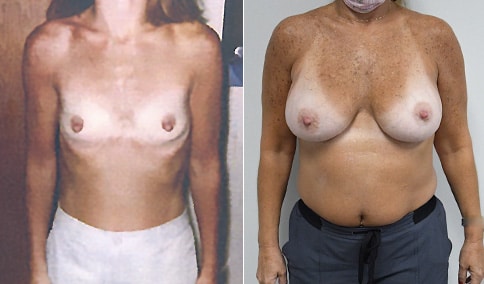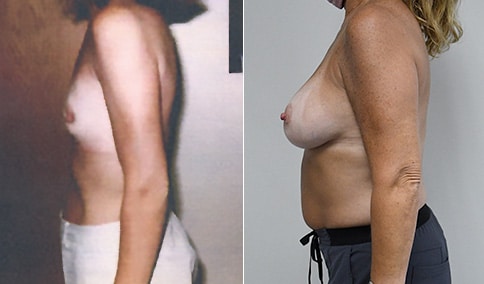“Should I Have My Implants Replaced Because They Are X Years Old?
The question often comes up: “Should I have my implants replaced because they are X years old?”
I wanted to share a patient whom I saw recently in the office and has kindly given permission to share her photos and story.
A lovely mother of 5 in her early 50’s had breast augmentation with us when she was in her mid 30’s, more than 18 years ago. She is doing great, but wondered if she should have her implants replaced “before they have a problem”. She says that the breast augmentation is “the best thing she has ever done”. Reviewing her records, she had Mentor smooth round saline moderate profile implants 325-375 filled to 375 cc and placed through an inframammary incision and below the pectoralis muscle. I had to dig up the old Polaroid photos from before her surgery, and I apologize for the photo quality of a scanned polaroid photo that has been printed out on a color printer and then scanned into the computer so we could show it here. It does show that her breasts have a deflated appearance after her multiple pregnancies. It is remarkable how well she continues to do: the 375 cc implants are properly sized to her frame and breast dimensions and have filled the breasts deflated from multiple pregnancies without overly stretching them. She loves having a natural appearance in and out of clothing. The breasts have remained soft.

I like to fill a saline implant to the recommended top end of the range because it is less likely to have a crease or “fold flaw” that could weaken the shell and lead to an earlier failure. I also use a temporary implant as a sizer at the time of surgery to avoid having to work around the actual implant with any instruments that could scratch or weaken the shell. The “no touch technique” prevents the implants from touching the skin as they are inserted and nipple shields are placed over the nipples at the time of surgery to prevent any bacteria from the nipple ducts from contaminating the implant and perhaps causing a capsular contracture. Although silicone gel implants may have some advantages over saline implants, mainly the feel being softer, the saline implants have the advantage of knowing when they leak: the implant goes flat as the saline is absorbed by the body. So we don’t have to worry about a silent rupture.

So, should we replace 18-year-old saline implants that are not having a problem?
The answer here is no. I have seen patients who have had saline implants for 30 years that are still doing fine, and I have seen patients who have had a deflation after just 2 weeks. Around 10 % of breast implants have failed by 10 years, but that means that 90% are still ok at that time. So, she may hopefully have many more years of use from her implants and when they do fail it will be obvious and the saline will be harmlessly absorbed by the body. At that point I would probably replace both. But right now she continues to do well- “If it isn’t broken don’t fix it”
She was pleased to hear the good news.





Cosmetic & Plastic Surgery Specialist
"I treat my patients like I would treat
- Jonathan D. Hall, MD, FACSmembers of my own family."
Schedule Consultation